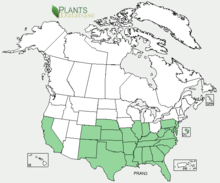- Prunus angustifolia
-
Prunus angustifolia 
Scientific classification Kingdom: Plantae Division: Magnoliophyta Class: Magnoliopsida Subclass: Rosidae Order: Rosales Family: Rosaceae Genus: Prunus Species: P. angustifolia Binomial name Prunus angustifolia
Marsh.Prunus angustifolia pronounced (PROO-nus an-gus-tih-FOLE-ee-uh)[citation needed], known commonly as Chickasaw Plum, Cherokee plum, Florida sand plum, sandhill plum, or sand plum,[1] is a plum bearing tree native to North America. It was originally cultivated by Native Americans before the arrival of Europeans. While Prunus is the classical name for European plums, angustifolia refers to its narrow leaves. It is listed by the USDA as an endangered species in the state of New Jersey.
Contents
Description
Chickasaw plum grows 12 to 20 feet tall and 15 to 20 feet wide in an irregular shape. It is "twiggy" in nature,and has a scaley, almost black bark. It's branches are reddish with a thorn-like, small side branches. In February, March, April and May small white flowers blossom, 8-9mm wide, along with red plums, up to 25 mm long. The flowers have five white petals with reddish or orange anthers. The plums ripen in late summer. It is perennial and also an evergreen. It requires low to medium amounts of water to grow, and dry, sandy or loose soil. It grows best in areas with regular sunlight or areas of partial shade. In sunny areas it will be more dense and colonize for thickly. In areas of partial shade, it will be thinner, less dense, and each plant with be more spread out.
Location
Prunus angustifolia is native to the United States and can be found in Alabama, Arkansas, California, Colorado, District of Columbia, Delaware, Florida, Georgia, Illinois, Indiana, Kansas, Kentucky, Louisiana, Maryland, Missouri, Mississippi, North Carolina, Nebraska, New Jersey, New Mexico, Oklahoma, Pennsylvania, South Carolina, Tennessee, Texas, Virginia, and Washington. They grow in dry and sandy soils, such as open woodlands, woodland edges, forest openings, savannahs, prairies, plains, meadows, pastures, and roadsides.
Uses
Chickasaw plums tend to bloom early in the spring. Because they bloom early in the spring, before many other plants bloom, and require very little maintanence, they are often used in horticulture for ornamental use. They are found along many highways, especially in the southern part of the United States. In wildlife the fruit is eaten by various animals. It also provides cover for nesting sites. Ripe fruits are slightly tart, but can be eaten or are sometimes made into jellies, desserts and presercves. Because of its attractive bark, small leaves and thin branches, Chickasaw plum is also sometimes used for bonsai.
Reference
- Edward F. Gilman and Dennis G. Watson. "Prunus angustifolia: Chickasaw Plum1". http://edis.ifas.ufl.edu/st504. Retrieved 3 May 2011.
- Oklahoma Biological Survey
- USDA Prunus Angustifolia
- Virginia Tech Department of Forest Resources and Environmental Conservation
- Floridata Prunus Angustifolia
- The University of Texas at Austin Lady Bird Johnson Wildflower Center
- Kansas Forest Service
Categories:
Wikimedia Foundation. 2010.


